Customer advocates can help businesses succeed. They drive sales, ensuring your company grows. In fact, according to Harvard Business Review, a 12% growth in customer advocacy can lead to a 200% boost in revenue.
But that’s not all.
Customer advocates can also help your email marketing in many ways. This blog delves specifically into the role of customer advocacy in email marketing. It helps you visualize how your customer advocates fit into your overall email marketing strategy. But let’s not get ahead of ourselves.
Customer advocacy is when loyal customers promote your brand or product to others for free. The promotion can take many forms, including:
These types of social proof are highly effective, as they tap into the trust and credibility that these customers have built with their own networks.
Note, though, that customer advocates aren’t created overnight. For consumers to do this promotion for you, you need to give them excellent experiences (emphasis on the “s” there) at every turn. From your brand’s website to your sales process and customer service, you need to surprise and delight. When you do this, you won’t even have to ask them to spread the good word about your brand. They’ll do it on their own–free of charge.
When happy customers promote your brand to others, they tend to go all out. A staggering 72% of them will share their positive experiences with six or more people. That’s a lot of brand exposure for you.
That’s not all. With that increased brand exposure come even more positive results. As more happy customers spread the good news, more people see your brand in a positive light as well. In other words, your brand reputation improves overall.
Customer advocacy also plays a crucial role in building loyalty and trust with your current customers. Over 80% of consumers trust recommendations from people they know more than other channels. So, if they say your brand is great, consumers will believe them.
Because of these benefits, customer advocacy has a significant impact on conversion rates and sales. Almost 60% of US consumers say a company’s reputation is a “major factor” in their purchasing decisions. Also, seven out of ten customers prefer to buy more from brands they trust. In short, with customer advocacy, as I briefly mentioned, you can achieve overall business growth.

Customer advocates can help boost your email marketing in many ways. Here are some of those ways:
Customer advocates are vital to the success of your referral programs. They are enthusiastic consumers eager to tell their friends and family about your product or service. Their favorable experiences serve as trusted sources of information, providing valuable insights and personal anecdotes that can help build trust and credibility for your brand. Furthermore, customer advocates often have a solid understanding of the brand’s values and offers, making them adept at communicating the benefits and advantages of your business.
However, creating an enticing email message that emphasizes the advantages and rewards of participating in referral programs is still crucial to getting customer advocates to participate. In your email, you should highlight their value as advocates and how their support can impact the brand’s success.
Also, produce engaging, not boring email content. Focus on your subject lines as well. These are the first things your customer advocates will see. You can use generative AI for email marketing to write. With it, you can save time and improve email campaign effectiveness by also ensuring highly targeted messaging.
Just as important is providing clear instructions on how to join the program and outlining the rewards customers can earn for successful referrals. In your email, offer incentives such as discounts or exclusive rewards to motivate advocates to take action then and there:
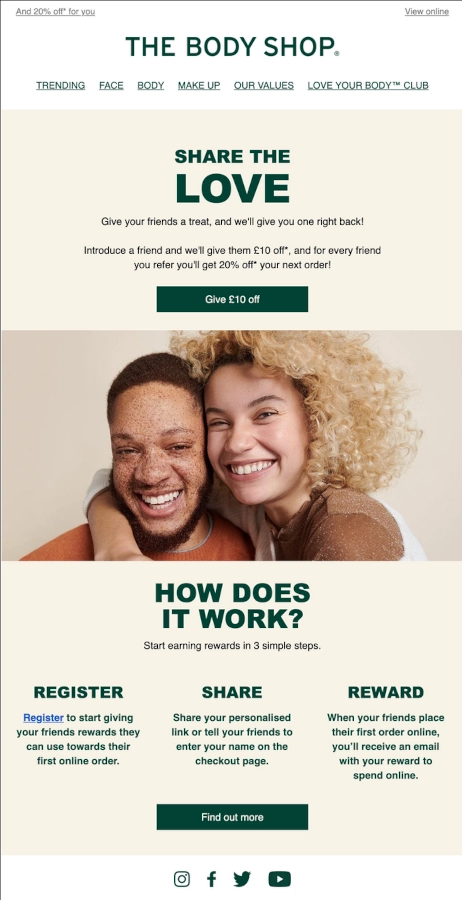
Image via The Body Shop
The referral program invitation email above is an excellent example. The brand provides straightforward instructions for participation. Also, the email doesn’t assume the subscriber will join the program immediately. It also includes a call-to-action for people who want to know more about it before participating.
Finally, regularly reminding customers about the referral program through follow-up emails can help keep it top of mind and increase participation rates. Use email newsletter tools like GetResponse to automate the process. This way, you won’t have to spend too much time manually sending the follow-up emails yourself. As part of your follow-up, show gratitude and appreciation toward your advocates for their support and loyalty after they join the program.
Customer advocates typically feel a deep sense of loyalty towards the brands they support. They have an honest desire to see these companies thrive. So, when you send them an email seeking their feedback for you to improve your products and services, they’ll gladly answer. And their answers are detailed, too. After all, they know you more than anyone else.
That said, making the feedback process simple is still vital if you want advocates to offer meaningful and thorough feedback. See how easy it is to leave comments for Slack. Customers just need to click on the Take Survey button:
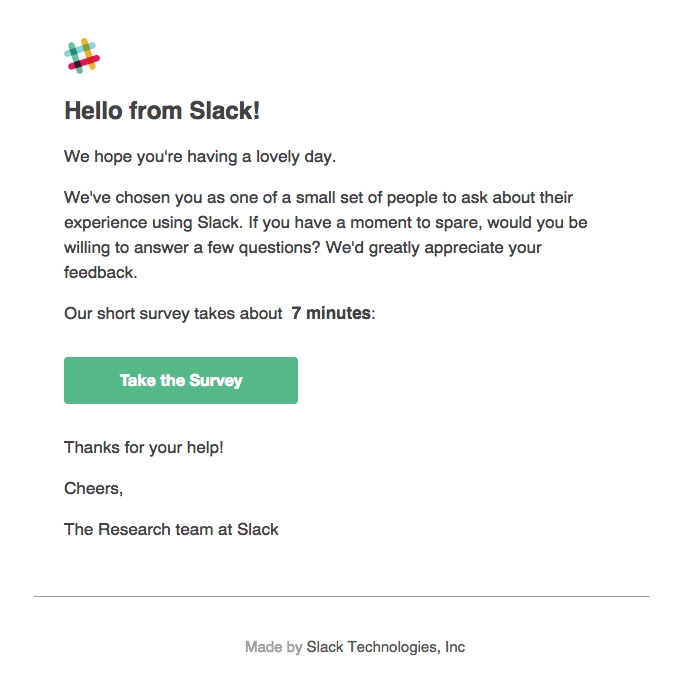
Image via Slack
Also, like Slack, make your feedback surveys short and sweet. It should take people no more than 10 minutes to complete them.
Don’t just hit that Send button once you’re done crafting your emails, though. You don’t want to skip the email verification process that helps you validate the legitimacy of advocates’ email accounts. This process can help you maintain a clean advocate database, increasing content distribution and engagement.
Finally, keeping customer advocates informed on the progress of their feedback’s implementation demonstrates that their opinions are valued, encouraging them to keep submitting their thoughts.
Consumer advocates, without a doubt, create the finest testimonials. They are loyal customers who actively recommend you on channels such as review sites and social media for all the world to see. Their testimonials hold great weight as they genuinely believe in the value and benefits offered.
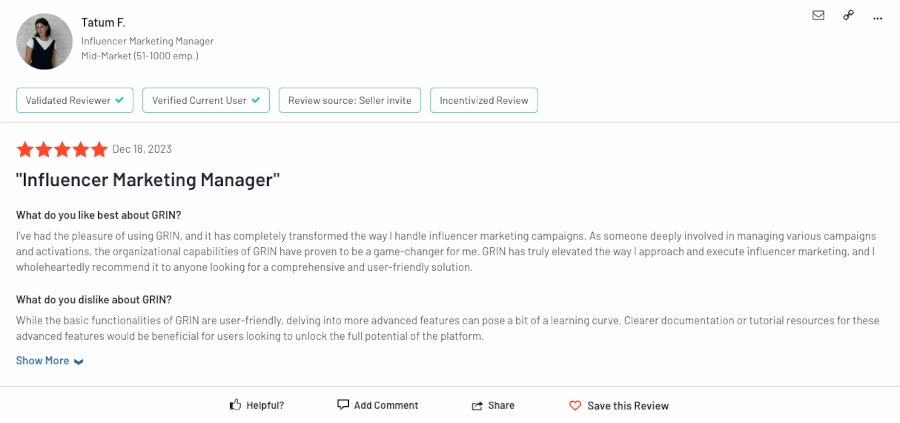
Image via G2
You can use this social proof to build brand trust and credibility for your other subscribers who haven’t tried your product. There are social listening and media monitoring tools you can use to collate testimonials about your brand online for use in your emails.
But when it comes to including customer testimonials in your email marketing campaigns, there are still a few key tips to keep in mind.
Selecting testimonials that are relevant to the business or product you are advertising should be your first priority. Prioritize those with details on the customer’s experience. You want to demonstrate to prospective clients that your product or service has helped others in similar situations.
Additionally, consider using testimonials that highlight different aspects of your business. This will ensure your brand appeals to a larger pool of possible clients.
Take a look at this email as an example. Notice how the majority of the reviews touch on different aspects of the product—the cut, the wash, the fabric.
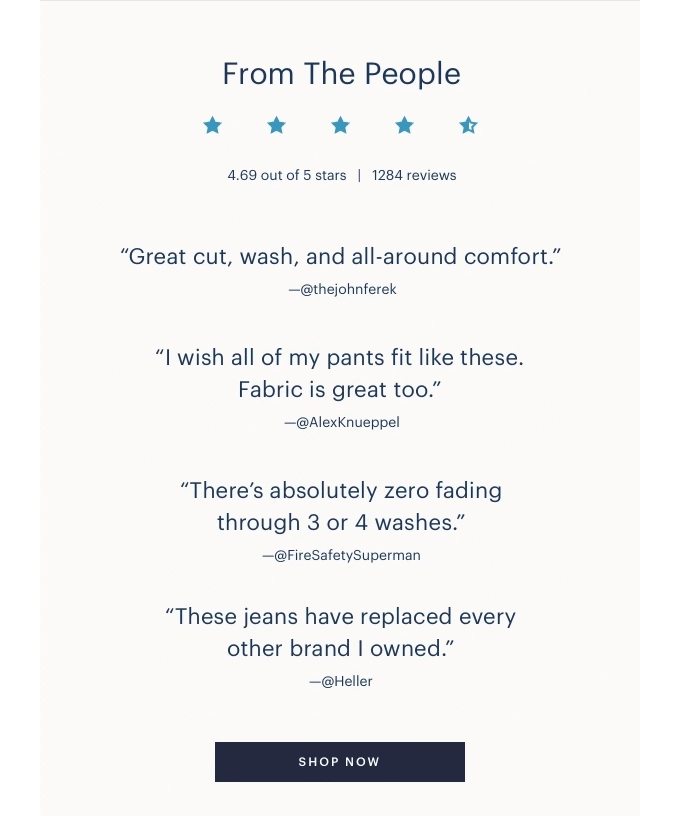
Image via Everlane
Also, to make the testimonial more credible, it would be great if you could provide the customer’s name and other pertinent details, like their job title or industry.
Finally, always obtain explicit permission from the customer before using their testimonial, and consider offering an incentive or discount for their participation.
Customer rewards emails like the referral program email we mentioned above are targeted emails used to engage your current customer base. These initiatives aim to encourage customer retention and instill a sense of brand loyalty.
There are other customer rewards campaigns apart from referral programs. Some brands, for instance, launch campaigns that reward loyal customers with points per dollar spent on purchases. See this Starbucks rewards email campaign:

Image via Starbucks
Others reward loyal customers for sharing social media posts. True Citrus, for instance, provides exclusive promotions and offers for sharing their social content. It has VIP tiers, too:
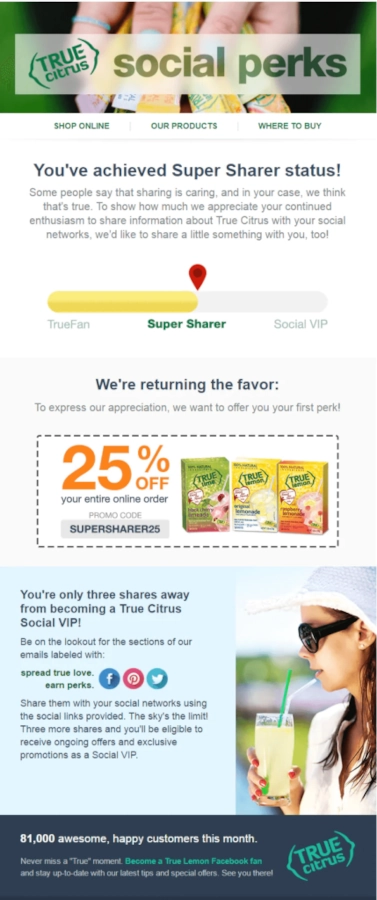
Image via True Citrus
Whatever the nature of your program, customer advocates are more likely to eagerly contribute. Just make it easy for them to take your desired action in your email campaigns. For instance, in the Starbucks example, customer advocates only need to click on the email’s “Order” button to buy and earn points. In the True Citrus example, they just need to click on any of the social icons to get to their platform of choice and start sharing.
Finally, monitor and assess the success of your email campaigns regularly. Analyze open rates, click-through rates, and conversion rates to learn the types of email content that urge customer advocates to take action.
We know customer advocates love spreading the good word about you through user-generated content. But that UGC doesn’t only come in the form of testimonials. It also comes in the form of content–usually posted on social media—that doesn’t necessarily see customer advocates explicitly reviewing your product. For instance, a customer advocate may post a picture of them using your item. Or they may post a behind-the-scenes video of your event they attended.
You can include these types of user-generated content (UGC) in your emails as well. Like the testimonials, they can add authenticity and credibility to your marketing messages. After all, they allow other subscribers to see real people enjoying your brand. Incorporating UGC of this kind may also stimulate user interaction and help you build a brand community leveraging your already loyal customers.
Collate this UGC type by using social listening tools. But before you incorporate the content into your emails, make sure you, again, ask for customers’ permission to do so.
Another option is to run contests on social media specifically for the purpose. Just schedule the post announcing your contest for publication at a time your target audience is active on the platform. This will help ensure maximum engagement. You can check general research data for this if you don’t have historical social media data. For example, if your target audience is primarily active on Instagram, schedule Instagram posts on Mondays from 10 a.m. to noon. Or if they’re on Facebook, post on Wednesdays and Thursdays, between 7 a.m. to 9 a.m., 1 p.m. to 3 p.m., and 7 p.m. to 9 p.m. You can mention the winner will be featured in your email marketing campaigns.
You can incorporate your collated UGC into your emails in different ways. Post them directly on an email to encourage other subscribers to create similar content on social media. Or, you could do what West Elm did below. The brand used images taken by its customers to showcase its products, then wrapped up the email with a Shop Now call-to-action:
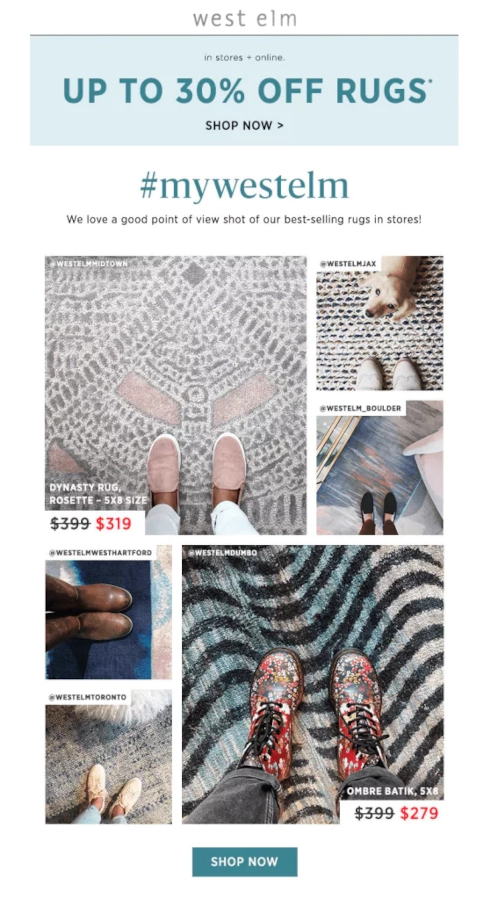
Image via West Elm
Like West Elm, you can further urge them to buy from you by offering a discount on select items.
Businesses must recognize and actively nurture customer advocates. After all, they’re key to business success. They make repeat purchases and enhance the business’s reputation.
There’s a role to play for customer advocacy in email marketing as well.
Customer advocates can give your referral program, email feedback and rewards email campaign results a boost. Also, customer advocates post customer testimonials and other types of UGC, which you can use as email marketing content.
Overall, if you haven’t sought the help of your fiercely loyal customers, you’re missing out. Do it now, and you’ll soon see your business soar to greater heights.
Our team keeps a finger on the pulse, so you’re always working with the latest information.